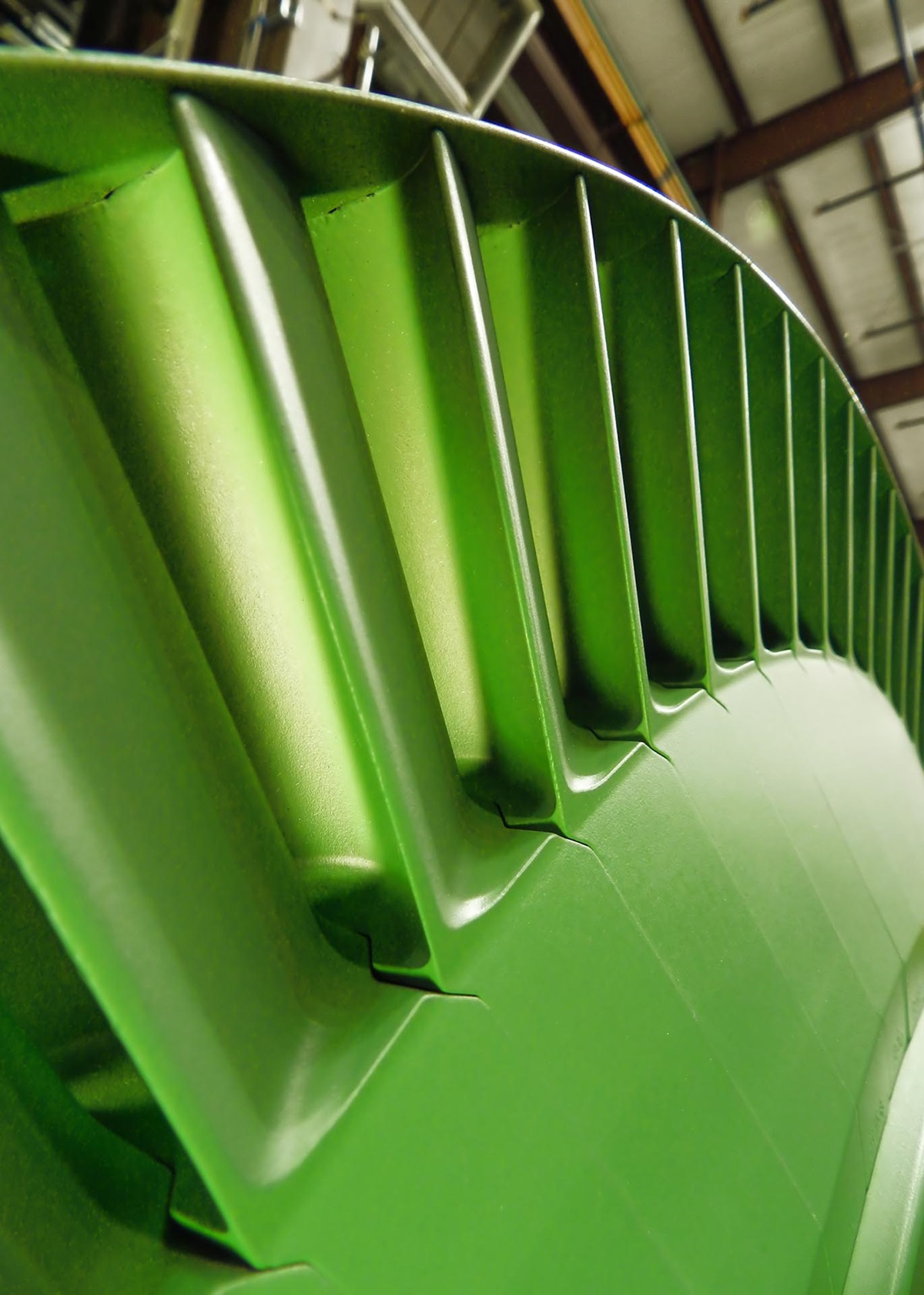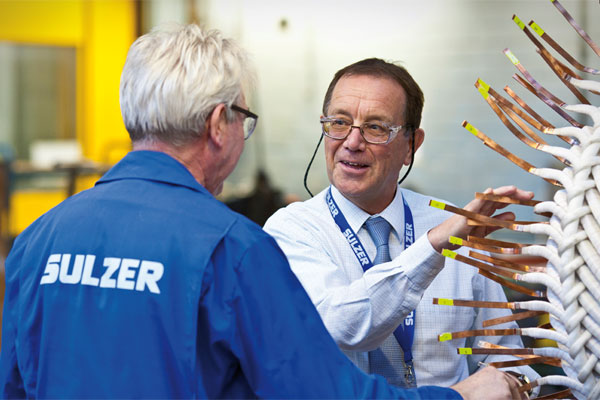Customized protective coatings
Protective coatings for long-term reliability
Travis Cockrell, Component Superintendent of the Coating Department at Sulzer’s Houston Service Center, looks at some surface protection processes and technologies that are now being used to increase the durability of rotating equipment used in demanding operating environments.
Long-term reliability is a common goal for all plant operators, achieving it requires a considered approach that takes into account a range of contributory factors and makes use of the most appropriate technology and manpower available to them. Rotating equipment that is in direct contact with the process media and under constant attack, presents a major challenge; it is possible, however, to reduce degradation to a minimum by selecting the correct coating system.
Generally, turbines, compressors and pumps, are all subject to a variety of environmental conditions that contribute to corrosion, erosion, fouling and various temperature related issues. The first step is to understand the operating environment of the machinery. From there, the sources of degradation can be classified and specific coating systems can be used to increase efficiencies, lengthen the interval between scheduled maintenance and reduce the occurrence of unscheduled maintenance events.
Effects on performance
The flow path of air and fuel through a gas turbine presents a number of different conditions that can have an adverse effect on the performance of the turbine. The combination of heat, microscopic abrasives and a gradually increasing concentration of corrosive elements can cause significant damage to a once smooth airfoil surface. As the surface finish slowly degrades, the efficiency of both the compressor and turbine is reduced.
Metallic coatings for compressor section
This process can be arrested in the compressor section of the gas turbine, and the surface finish restored, by the application of suitable metallic coatings. There is a range of options open to suit the specific duty of the turbine in question, but all include a type of metal deposition where a tough corrosion resistant surface is created.
An aluminum base layer is typically used in gas turbine compressors for corrosion protection of ferritic/martensitic steel components in moist conditions. It provides galvanic protection, which means that small scratches to the surface layer are less likely to cause corrosion. It is produced by spraying a slurry of aluminum and an inorganic binder, rendered insoluble by a medium-temperature baking process. This layer can then be covered by a harder layer that might include metals such as Chromium.
The harder layer is usually applied using a spray coating method such as Chemical Vapor Deposition (CVD), Air Plasma Spraying (APS), Low Pressure Plasma Spraying (LPPS) or High Velocity Oxygen Fuel (HVOF) - which one will depend on the coating thickness required and the sensitivity of the part to heat, as some processes are hotter than others. By applying corrosion inhibiting and surface finish enhancing coatings to the compressor section it is possible to increase the efficiency and extend the service life of the gas turbine.
Corrosion and oxidation protection for hot section
Modern gas turbine hot section components are made using nickel or cobalt based superalloys, which are designed to operate in high temperatures. However, these alloy compositions are less well suited to providing corrosion and oxidation protection and need to be supplemented with custom coatings that can deliver the hot corrosion and oxidation protection required for extended service lives. The process of oxidation causes a layer of metal-oxide to form on the surface, which, in general, protects the underlying material. Therefore the oxidation process slows down as the thickness of the oxide layer increases. This process can be replicated with the intentional formation of oxides that provide a protective layer preventing further atmospheric attack.
Corrosion of a gas turbine component usually occurs in one of two ways. Hot corrosion may take place between 1450 and 1650 °F and it attacks the entire surface of the component. Alternatively, corrosion at cooler temperatures is more localized and therefore tends to create distinct layers of oxide and exposed metal. Further damage can be caused by erosion which involves repetitive mechanical abrasion by particles in the air stream.
Standalone High Velocity Oxygen Fuel applied MCrAlY coatings are sufficient to combat corrosion/oxidation at lower firing temperature gas turbines. For newer technology, higher firing temperature gas turbines, the combination of a MCrAlY bond coat coupled with a ceramic thermal barrier coating will reduce the surface temperature of the substrate and reduce the degenerative effects of oxidation and corrosion.
Keeping in balance
In all turbomachinery applications, dynamic balance is a crucial requirement, so the application of any coating system has the potential to upset the balance of a turbine or compressor, even if it is only a few microns in thickness. It is therefore essential that the component being coated is checked for balance both before and after the protection layer is applied.
The techniques and equipment used to apply the latest coatings depends largely on the type of coating being applied and the function of the component. Coatings that are designed to provide high temperature corrosion resistance are often applied using a HVOF gun, which produces a dense coating with a high bond strength.
Due to the precision required in manufacturing and maintaining high temperature turbine blades, these coatings should be applied using a robotic manipulator with automated thermal spray equipment. In this way, the coating is applied uniformly on each blade by removing the human error that is associated with hand spraying. Balancing should then be carried out to ensure each machine will operate perfectly after being protected.
Improving efficiency
With such high energy requirements, the hydrocarbon processing industry often uses on-site generation plants and the growing demand for power has led to significant research into improving production efficiency. Essentially this can be divided into combustion efficiency and mechanical efficiency.
Combustion efficiency looks at increased combustion temperatures which require the latest coating technologies to prevent heat damage to the components in the hot gas flow.
Mechanical efficiency looks at reducing losses in the power train, including the clearance between the rotor blades and the stator casing. The clearance is crucial in determining the efficiency of the turbine and therefore a large part of its costs and productivity. Zirconia-ceramic materials can be used to minimize this clearance in high temperature applications. Clearance-control coatings or abradable coatings, function by allowing a rotating part, such as a blade, to cut a path in a sealing abradable layer with minimum clearance. Many advanced gas turbines use a thick ceramic coating to impart both thermal-barrier and abradability properties.
Future proofing
As design technology and materials’ science advance the newest generation of turbine components can present a considerable challenge to repair specialists. Finding the most suitable coating depends on a number of factors including adhesion qualities, heat and erosion resistance as well as compatibility with the design of the component.
For example, the challenges of protecting components, especially those within the hot section of a gas turbine, are considerable, especially when the temperature of the combustion gas is higher than the melting point of the base materials. The combination of internal cooling ducts and a thermal barrier coating (TBC) work together to maintain the desired component temperature. The latest turbine blades are designed with a large number of tiny cooling holes, often in excess of 500 in a single part, which must remain unaffected by the coating process.
Conventional thermal spraying processes would block off many of the holes, rendering the cooling system almost useless. However, new coating techniques are required to ensure that none of the cooling ducts are closed off by using conventional plasma spraying processes. Sulzer has addressed this and many other challenges in this area to deliver a bespoke service that ensures the latest techniques are adapted to suit each application.
It is essential that repair specialists, such as Sulzer, continue to develop new coatings and new application methods that can keep pace with the advances in the turbomachinery sector. In this way, plant operators will have the confidence to invest in repairs that have the ability to provide many years of continued service.



